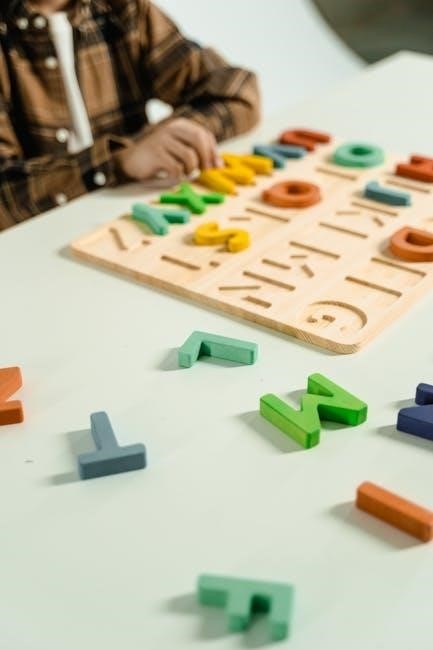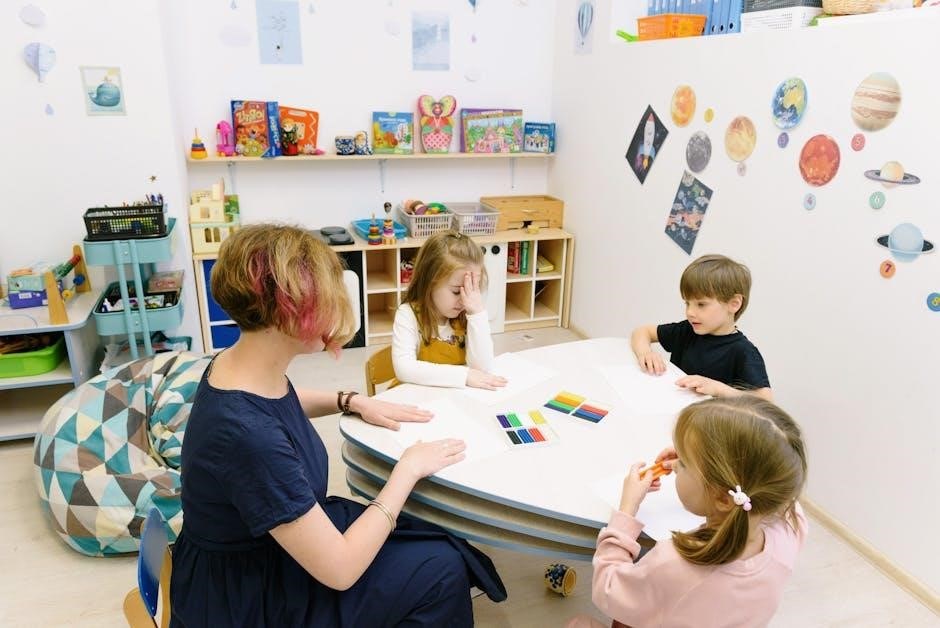Weekly lesson plans for preschool provide a structured framework for organizing activities, ensuring alignment with curriculum goals, and fostering a balanced approach to early childhood education.
1.1 Importance of Structured Learning
Structured learning is essential for preschoolers, as it provides a sense of routine and stability, which are critical for young children’s cognitive, social, and emotional development. A well-organized weekly lesson plan ensures that activities are purposeful and aligned with curriculum goals, promoting holistic growth. By incorporating structured learning, teachers can help children develop essential skills such as problem-solving, creativity, and communication. It also fosters independence and self-discipline, as children learn to follow a daily schedule and complete tasks. Additionally, structured learning allows educators to track progress and identify areas where children may need extra support. This approach ensures that all aspects of development—literacy, math, art, and physical activity—are addressed systematically, creating a strong foundation for future academic success.
1;2 Benefits of a Weekly Lesson Plan
A weekly lesson plan offers numerous benefits for preschool teachers and students. It helps educators organize activities efficiently, ensuring a balance between play and structured learning. By using a weekly plan, teachers can align lessons with curriculum goals, making learning purposeful and focused; It also allows for the integration of various subjects, such as literacy, math, and art, into daily routines. A well-designed plan saves time, reduces stress, and ensures consistency in teaching. Additionally, it provides a clear roadmap for the week, helping teachers prepare materials and activities in advance. For students, a weekly plan fosters predictability and routine, which are essential for young learners. It also allows teachers to track progress and make necessary adjustments, ensuring that all children meet developmental milestones. Overall, a weekly lesson plan is a valuable tool for creating a productive and engaging learning environment. It promotes organization, accountability, and effective teaching practices.
1.3 Overview of Preschool Curriculum Goals
Preschool curriculum goals focus on fostering holistic development in young children, encompassing social, emotional, cognitive, and physical growth. These goals are designed to build foundational skills that prepare children for future academic success. Key areas include literacy, numeracy, creativity, and social interaction. Literacy skills involve recognizing letters, understanding stories, and developing language abilities. Numeracy introduces basic math concepts like counting and shapes. Creative expression is encouraged through art, music, and imaginative play. Social skills, such as sharing, cooperation, and conflict resolution, are also prioritized. Physical development includes fine and gross motor activities, like drawing and outdoor play. Curriculum goals are aligned with age-appropriate milestones, ensuring activities are engaging and tailored to each child’s needs. By achieving these goals, preschoolers gain confidence, curiosity, and a love for learning, laying a strong foundation for their educational journey. These objectives guide weekly lesson plans, ensuring a balanced and enriching experience for all students.

Key Components of a Preschool Weekly Lesson Plan
A preschool weekly lesson plan includes learning objectives, daily schedules, activity breakdowns, and integration of skills like literacy, math, and art to ensure a well-rounded educational experience.
2.1 Learning Objectives and Outcomes
Learning objectives and outcomes are central to a preschool weekly lesson plan, defining what children should achieve through structured activities. These objectives are aligned with early learning guidelines, ensuring developmental milestones are met. For example, literacy skills may focus on recognizing letters, while math objectives might involve basic counting. Outcomes are observable results, such as improved Fine motor skills through art projects or enhanced social interactions during group play. Clear objectives guide teachers in planning meaningful activities and assessments, allowing them to track progress effectively. They also ensure that lessons are purposeful and aligned with the broader curriculum goals, fostering a balanced and comprehensive learning experience for young children.
2.2 Daily Schedule and Activity Breakdown
A well-structured daily schedule is essential for preschool lesson plans, ensuring a balance of activities that cater to different learning styles and developmental needs. The schedule typically includes time blocks for arrival and morning routines, circle time, literacy, math, science, art, outdoor play, and transitions. Each activity is designed to promote engagement and skill development, such as group discussions for social skills or hands-on crafts for fine motor abilities. The breakdown allows teachers to allocate sufficient time for each task, ensuring a smooth flow of the day. This structured approach helps children feel secure and fosters a sense of routine, while also providing opportunities for exploration and creativity. By organizing activities thoughtfully, teachers can meet the diverse needs of their students and ensure a productive learning environment. Regular breaks and transitions are also planned to maintain young children’s focus and energy levels throughout the day.
2.3 Integration of Multiple Skills (Literacy, Math, Art)
Weekly preschool lesson plans often emphasize the integration of multiple skills, such as literacy, math, and art, to create a holistic learning experience. Activities are designed to connect these areas seamlessly, fostering a deeper understanding and engaging children on multiple levels. For example, a literacy activity focused on counting books can incorporate math skills, while an art project involving shapes and colors can reinforce both math and literacy concepts. This cross-curricular approach helps children make connections between different subjects and develops their critical thinking and creativity. By integrating skills, teachers ensure that learning is comprehensive and engaging, preparing young students for future academic success. This method also supports the natural way children learn—by exploring and connecting new ideas and experiences.

Benefits of Using a PDF Template for Lesson Planning
Using PDF templates for lesson planning offers a professional, organized, and reusable format, saving time and ensuring consistency in curriculum delivery for preschool educators.
3.1 Professional and Organized Appearance
A PDF template ensures a professional and organized appearance for preschool lesson plans, presenting activities and objectives in a clear, visually appealing format. This structure helps teachers maintain consistency and clarity, making it easier to communicate their plans to colleagues and parents. The uniform layout allows for better readability, ensuring that all essential details, such as learning objectives, daily schedules, and activity breakdowns, are prominently displayed. Additionally, a professional format enhances the overall presentation, reflecting the teacher’s commitment to structured and high-quality education. By using a PDF template, educators can achieve a polished look that aligns with educational standards, while also balancing creativity and practicality in their lesson planning.
3.2 Reusability and Customization Options
One of the key advantages of using a PDF template for preschool lesson plans is its reusability and customization options. Teachers can reuse the same template week after week, adapting it to fit different themes, age groups, and learning objectives. The ability to customize ensures that each lesson plan remains relevant and engaging, catering to the diverse needs of young learners. With editable sections, educators can easily modify activities, outcomes, and schedules without starting from scratch. This flexibility not only saves time but also allows for consistent planning, ensuring that each week’s curriculum builds upon the previous one. Moreover, customization options enable teachers to incorporate specific skills, such as literacy, math, and art, into their plans, making the learning experience comprehensive and tailored to their students’ development.
3.3 Time-Saving Features

Using a PDF template for preschool lesson planning offers significant time-saving benefits. Pre-designed layouts and sections eliminate the need to create a structure from scratch, allowing teachers to focus on content rather than formatting. The ability to reuse templates week after week reduces preparation time, as educators can simply update activities and objectives. Additionally, digital templates enable quick edits and adjustments, streamlining the planning process. Many templates also include pre-built sections for daily schedules, learning objectives, and activity breakdowns, further saving time. This efficiency allows teachers to allocate more time to delivering engaging lessons and supporting student development, rather than spending hours on administrative tasks. Overall, PDF templates are a practical solution for busy educators seeking to maintain organized and effective lesson plans.

How to Create a Weekly Lesson Plan from Scratch
Creating a weekly lesson plan from scratch involves defining learning objectives, structuring daily schedules, and integrating various skills like literacy, math, and art into engaging activities for young learners.
4.1 Steps to Design a Template
Designing a weekly lesson plan template involves outlining sections for learning objectives, daily schedules, and activity breakdowns. Start by identifying key components such as literacy, math, and art. Next, allocate time slots for each activity, ensuring a balance between structured and free play. Include space for notes and feedback to track progress. Use a clear and organized layout to enhance readability. Finally, customize the template to accommodate different themes and age groups, making it adaptable for various teaching needs. This structured approach ensures consistency and efficiency in planning engaging and educational activities for preschoolers.
4.2 Tools and Resources for Creating PDF Templates
Creating a weekly lesson plan template in PDF format can be streamlined using tools like Canva, Adobe Acrobat, or Google Docs. These platforms offer customizable layouts and design elements to suit preschool curriculum needs. Websites such as Teachers Pay Teachers and Pinterest provide free and paid templates that can be downloaded and edited. Additionally, tools like Microsoft Word and Google Slides allow for easy customization before converting to PDF. Many preschool teachers also use online resources like Teaching Strategies and Education.com for pre-designed templates. These resources ensure that lesson plans are professional, organized, and aligned with educational goals, saving time and effort in the planning process.
4.3 Common Mistakes to Avoid
When creating a weekly lesson plan for preschool, common mistakes include overloading the schedule with too many activities, resulting in a lack of flexibility. Teachers should avoid making lesson plans too rigid, as young children often need spontaneity and adaptability. Additionally, failing to align activities with curriculum goals can lead to disjointed learning experiences. It’s also important to ensure that each activity is age-appropriate and engaging, avoiding overly complex tasks that may frustrate students. Neglecting to include breaks and transition times can disrupt the flow of the day. Lastly, not leaving room for feedback or reflection can hinder the ability to assess the effectiveness of the lesson plan and make necessary adjustments for future weeks.

Tips for Customizing Your Preschool Lesson Plan
Customize by incorporating weekly themes, adapting activities for different age groups, and adding visual elements to engage young learners and promote interactive learning experiences.
5.1 Incorporating Weekly Themes
Incorporating weekly themes into your preschool lesson plan enhances engagement and structure. Choose themes like “Letters,” “Plants,” or “Seasonal Activities” to align with curriculum goals. Each theme should integrate literacy, math, and art, making learning fun and cohesive. For example, a “Letters” theme might include alphabet crafts, storytelling, and phonetic games. Themes help organize daily activities, ensuring a balanced approach to skill development. They also encourage creativity and curiosity, as children explore related topics through play and structured tasks. Teachers can adapt themes to suit different age groups and add visual elements like posters or interactive props. This approach not only simplifies planning but also ensures that each week’s activities are meaningful and interconnected, fostering a love for learning in young children.
5.2 Adapting for Different Age Groups
Adapting weekly lesson plans for different age groups ensures that activities cater to the developmental needs of toddlers, preschoolers, and kindergarteners. For younger children, focus on sensory play and motor skills, while older groups can engage in more complex tasks like alphabet recognition. Customize templates to include age-specific activities, such as puzzles for toddlers or reading exercises for kindergarteners. This approach ensures that each child progresses at their own pace. Teachers can use editable PDF templates to tailor lesson plans, incorporating visual aids and interactive elements. For example, a “Letters” theme might include tracing for toddlers and word formation for older children. By adapting activities, educators create an inclusive and effective learning environment, ensuring that every child benefits from the structured curriculum. This flexibility is key to meeting diverse developmental needs and fostering growth across all age groups.
5.3 Adding Visual and Interactive Elements

Incorporating visual and interactive elements into preschool lesson plans enhances engagement and learning. Use images, charts, and colorful illustrations to make activities appealing. Interactive elements, such as puzzles, games, and crafts, encourage hands-on participation. Digital templates allow for embedding videos or audio clips to enrich lessons. For example, a theme-based lesson on animals can include pictures, songs, and matching games. These elements cater to different learning styles, ensuring all children stay engaged. Teachers can also add clickable buttons or links in PDF templates for easy access to additional resources. By integrating visual and interactive components, lesson plans become dynamic and immersive, fostering creativity and active learning in young children. This approach makes learning fun and effective, helping preschoolers develop essential skills in an engaging environment.

Using Free Printable Lesson Plan Templates
Free printable lesson plan templates offer convenient organization and customization for preschool educators. They provide structured formats for outlining activities, themes, and learning objectives, saving time and ensuring consistency.

6.1 Where to Find Reliable Resources
Reliable resources for preschool lesson plan templates can be found on educational websites like Teachers Pay Teachers, Canva, and Pinterest. These platforms offer a variety of free and editable PDF templates designed specifically for preschool curricula.
Websites such as Teaching Strategies and Education.com also provide structured and customizable templates that cater to early childhood education. Additionally, platforms like Google Classroom and SlideShare host a range of downloadable resources created by experienced educators.

Many preschool-specific blogs and forums share free printable templates, often aligned with weekly themes or seasonal activities. These resources are easily accessible and can be tailored to meet the needs of individual classrooms.
Downloading these templates ensures a professional and organized approach to lesson planning, saving time and enhancing teaching efficiency.
6.2 How to Download and Edit PDF Templates
Downloading and editing PDF templates for preschool lesson plans is a straightforward process. Start by visiting reputable websites like Teachers Pay Teachers, Canva, or Education.com, which offer a wide range of free and premium templates.
Once you find a suitable template, download it to your device. For editing, use tools like Adobe Acrobat or free alternatives such as Smallpdf or ilovepdf. These tools allow you to fill in details, add text, and customize the template according to your needs.
Some templates are also editable in Google Docs or Microsoft Word after conversion. Ensure the final document is saved in PDF format for a professional appearance. By following these steps, you can efficiently create personalized weekly lesson plans for your preschool class.
6.3 Popular Websites for Preschool Teachers
Several websites are popular among preschool teachers for downloading and customizing weekly lesson plan templates. Teachers Pay Teachers offers a wide range of free and premium templates designed specifically for preschool educators. Canva provides editable templates with a user-friendly drag-and-drop editor, perfect for creating visually appealing lesson plans. Education.com is another reliable source, offering printable PDF templates and activities tailored for young learners. Additionally, Teaching Strategies and Pre-K Pages are well-known for their structured and curriculum-aligned lesson planning resources. These websites save time and ensure that lesson plans are engaging and developmentally appropriate for preschool students.
